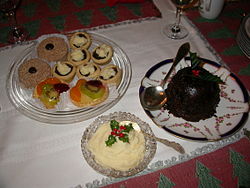Hard sauce
This article needs additional citations for verification. (December 2014) |
 Christmas dessert including hard sauce (lower centre) for pudding (and on tarts at upper left) | |
| Type | Sauce |
|---|---|
| Course | Dessert |
| Place of origin | England |
| Serving temperature | Cold |
| Main ingredients | Butter, sugar, flavouring (rum, brandy, whiskey, sherry, vanilla or other) |
Hard sauce is a sweet, rich dessert sauce made by creaming or beating butter and sugar with rum (rum butter), brandy (brandy butter), whiskey, sherry (sherry butter), vanilla or other flavorings. It is served cold, often with hot desserts.
It is typically served with plum pudding, bread pudding, Indian pudding, hasty pudding, and other heavy puddings as well as with fruitcakes and gingerbread.
In the U.K. brandy butter is particularly associated with the Christmas and New Year season and Christmas pudding and warm mince pies, serving as a seasonal alternative to cream, ice cream or custard. At Cambridge, it is also known as Senior Wrangler sauce.
Though it is called a sauce, it is neither a liquid nor smooth. It could be more accurately classified as a spread and has the consistency of butter. It is easy to make and keeps for months under refrigeration. It can be pressed into a decorative mold before chilling.
Under European Community regulations, to be called rum/brandy/sherry butter, it must contain at least 20% butterfat.[1]

See also
References
Notations
- Black, William. (2005). The Land that Thyme Forgot. Bantam. ISBN 0-593-05362-1. p. 350
Footnotes
- ^ "Commission Regulation (EC) No 445/2007 of 23 April 2007 laying down certain detailed rules for the application of Council Regulation (EC) No 2991/94 laying down standards for spreadable fats and of Council Regulation (EEC) No 1898/87 on the protection of designations used in the marketing of milk and milk products" [1]
